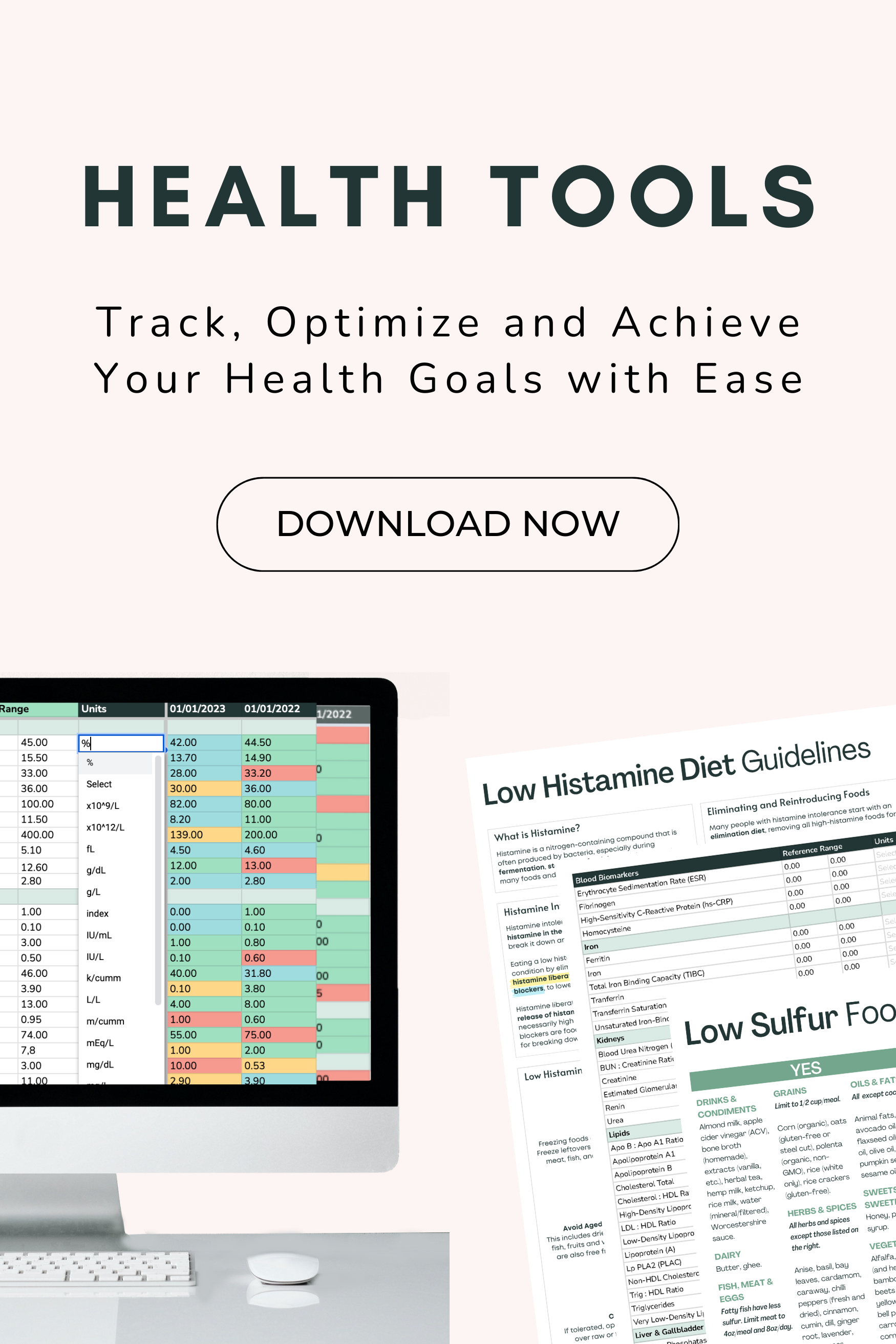Are Your Blood Sugar Levels in Check? Key Markers to Monitor.
By Tamara Agusta, MSc, DipION, NgC, mBANT - Written April 21, 2023
Are you struggling to shed those extra kilos? Do you experience irritability, fatigue, or mood swings when your meals are delayed? Are you constantly craving sugary or starchy foods? If so, then your blood sugar may need some attention. The International Diabetes Federation reports that over 500 million adults worldwide suffer from glucose dysregulation, which can increase the risk of various health problems if left unchecked. (1) Even if we appear healthy by conventional metrics, studies using continuous glucose monitoring (CGM) show that our glucose control may still be suboptimal. (2) This article covers some helpful markers to assess blood sugar health, so that you and your healthcare provider can work together to make informed decisions about your diet and lifestyle for optimal glucose control.
AI-generated image of sugar cubes in the bloodstream.
Fasting Blood Glucose
Fasting blood glucose is a standard test that measures the amount of glucose in the blood after at least 8 hours without food. (3) It is often measured as part of a basic blood panel but you can also check it at home using a glucose monitor. Glucose is the primary sugar that fuels your cells, and it can be used immediately or stored as glycogen in the liver and skeletal muscles for later. While the American Diabetes Association (ADA) defines a normal fasting blood glucose as less than 100 mg/dL (5.6 mmol/L), some studies have shown a greater likelihood of developing health problems at levels above 85 mg/dL (4.7 mmol/L), which may indicate the need for a lower cut-off for optimal levels. (3, 4, 5, 6)
Fasting blood glucose reference ranges:
Optimal: ≤ 85 mg/dL (4.7 mmol/L)
Normal: < 100 mg/dL (5.6 mmol/L)
Pre-diabetes: 100 to 125 mg/dL (5.6 to 6.9 mmol/L)
Diabetes: ≥ 126 mg/dL (7 mmol/L)
Glycosylated Haemoglobin (HbA1c)
HbA1c is a blood marker that predicts average blood glucose over the past 2-3 months, by looking at the percentage of haemoglobin that has become glycosylated—meaning bound with glucose—during the period of a red blood cell’s life. (7) When glucose lingers in the bloodstream for too long, it can bind to proteins and form advanced glycation end-products (AGEs). These AGEs can wreak havoc on our tissues and organs, and contribute to many of the health problems associated with metabolic disorders. (8) While HbA1c can be a great indicator of medium-term blood sugar control, it's important to remember that it doesn't reflect individual glucose fluctuations and may provide inaccurate results in certain clinical scenarios. (2, 9) To assess average blood glucose levels over shorter periods of 1-3 weeks, alternative tests such as fructosamine, glycated albumin, and 1,5-anhydroglucitrol (1,5-AG) can also be used. While the ADA defines a normal HbA1c range as less than 5.7%, a study in non-diabetic adults found that an HbA1c level of 5.3% may be a more appropriate cut-off for excluding the risk of pre-diabetes and abnormal glucose levels. (3, 10)
HbA1c reference ranges:
Optimal: < 5.3%
Normal: < 5.7%
Pre-diabetes: 5.7% to 6.4%
Diabetes: ≥ 6.5%
Postprandial Blood Glucose
Postprandial blood glucose is the glucose level in your blood after a meal. Measuring it is essential for understanding how your body responds to different foods and making informed decisions about your diet and lifestyle. The easiest way to measure postprandial blood glucose levels is through a continuous glucose monitoring (CGM) system, which provides real-time glucose readings throughout the day, including after meals. Unlike traditional tests that require blood draws, a CGM is a tiny device inserted under the skin that measures interstitial fluid glucose levels over several days. With uninterrupted insights into individual glucose fluctuations over time, CGM offers real-life feedback on your glucose management, taking into account other factors as well such as exercise, stress, sleep, and hormonal changes. (2, 11, 12, 13) The ADA advises that after eating, blood glucose should not go over 140 mg/dL (7.8 mmol/L) within 1-2 hours. (3) However, a study in non-diabetic adults suggests that it is healthier for post-meal glucose levels not to rise more than 30 mg/dL (1.7 mmol/L) above fasting baseline. (14) The goal is to avoid numerous and extreme fluctuations in glucose levels whatever your fasting level may be, because it’s the variability caused by the fluctuations that is most problematic. (15, 16, 17)
Image by Glucose Goddess
Several CGM sensors are available in the market, but you may require a prescription to obtain them depending on your location. Dexcom’s G7 and Abbott's Freestyle Libre are excellent options that are widely available internationally. If you’re based in the United States, you may want to consider Nutrisense or Levels, which offer personalised CGM-informed plans and programs to help you reach your health goals.
Postprandial blood glucose reference ranges:
Optimal: ≤ 30 mg/dL (1.7 mmol/L) above baseline, 1-2 hours after eating
Normal: < 140 mg/dL (7.8 mmol/L) 1-2 hours after eating
Pre-diabetes: 140 to 199 mg/dL (7.8 to 11.0 mmol/L) 1-2 hours after eating
Diabetes: ≥ 200 mg/dL (11.1 mmol/L) 1-2 hours after eating
Fasting Triglycerides
Triglycerides are a type of fat found in the diet, fat cells, and bloodstream. When we consume excess carbohydrates, our liver and muscle glycogen stores become full, and the extra glucose is converted into triglycerides and stored as fat. People with declining metabolic health may therefore have higher levels of circulating glucose and triglycerides, which makes triglycerides not only a useful marker for cardiovascular risk but a potential predictor of insulin resistance and blood sugar regulation. (18) While the conventional cut-off for triglycerides is 150 mg/dL (1.69 mmol/L), the American Heart Association (AHA) suggests that an optimal fasting triglyceride level should be less than 100 mg/dL (1.13 mmol/L). (19) A study in 8,068 adults supports this statement, as it found that cardiovascular risk persists well below the “normal” 150 mg/dL cut-off and that individuals with triglycerides below 82 mg/dL (0.92 mmol/L) had the lowest cardiovascular risk of all quartiles studied, indicating the need for a lower cut-off. (20)
Triglyceride reference ranges:
Optimal: < 82 mg/dL (0.92 mmol/L)
Normal (AHA): < 100 mg/dL (1.13 mmol/L)
Normal: < 150 mg/dL (1.69 mmol/L)
Fasting Insulin
Fasting insulin is a test that assesses insulin sensitivity and resistance by measuring the amount of insulin in the blood while in a fasted state. (21) Insulin is released when we eat and helps to get glucose into our cells for energy or storage. Insulin resistance occurs when cells become less sensitive to insulin, requiring greater levels to get glucose into the cells. Fasting insulin is a helpful marker for monitoring blood glucose health, as high levels of fasting insulin often precede high levels of fasting glucose by a number of years. (22, 23) This test is especially important if you're trying to lose weight because high insulin levels can make it difficult for your body to burn stored fat. (24) Additionally, if glycogen stores are full, insulin signals the body to convert excess glucose into fat. (25) Although there is no consensus on optimal fasting insulin levels—with normal reference ranges being quite broad—(26) a study from Iran found that a cut-off value of 7.51 μIU/mL in women and 5.48 μIU/mL in men can help predict type 2 diabetes with 75% sensitivity. (27)
Fasting insulin reference ranges:
Optimal: < 5.48 μIU/mL (< 38.06 pmol/L)
Normal: < 19 μIU/mL (< 131.94 pmol/L)
ALT/AST Ratio
Alanine aminotransferase (ALT) and aspartate aminotransferase (AST) are two enzymes that are commonly measured in blood tests to assess liver function. These enzymes are primarily found in liver cells and are released into the bloodstream when the liver is damaged or inflamed. While these markers are widely used for detecting liver disease, recent research has shown that the ratio of ALT to AST can also provide important insights into overall metabolic health; where a high ratio may signal declining glucose regulation, insulin resistance, and even undiagnosed type 2 diabetes. (28, 29) This is because the liver plays a key role in clearing insulin from the bloodstream. (30) A study from China suggests that an ALT/AST ratio cut-off of 0.80 for individuals without excess belly fat and of 0.78 for those with excess belly fat could be a reliable indicator of insulin resistance. (31) Excess belly fat was defined as having a waist circumference of 90 cm or more in males and 80 cm or more in females. So, if you want to keep your metabolic health in check, it's worth monitoring your ALT and AST levels, especially if you carry extra weight around your waist.
ALT/AST reference ranges:
Optimal: < 0.78
Normal: < 0.80
To sum up, keeping track of various blood glucose markers can be helpful, but we still need more research and guidance to determine optimal levels for maintaining good health and preventing disease. Traditional markers, measured at a single point in time, have limitations in providing a complete picture of glucose dynamics, which is where CGM can really shine. If you're concerned about your blood sugar levels, don't worry—controlling them is easier than you might think! I highly recommend checking out Jessie Inchauspé’s book “Glucose Revolution” for practical tips and advice on supporting healthy blood sugar regulation. Remember, though, it's always best to consult a qualified healthcare professional before making significant changes to your diet and lifestyle.
-
1. https://www.diabetesatlas.org
2. https://doi.org/10.1371/journal.pbio.2005143
3. https://doi.org/10.2337/dc22-S002
4. https://doi.org/10.2337/diacare.22.1.45
5. https://www.lifeextension.com/magazine/2004/1/awsi
6. https://doi.org/10.1016/j.ahj.2012.03.023
7. https://doi.org/10.4137/BMI.S38440
8. https://doi.org/10.1210/endocr/bqz006
9. https://doi.org/10.1007/s11606-013-2595-x
10. https://doi.org/10.2478/v10039-012-0030-x
11. https://doi: 10.2147/DMSO.S29222
12. https://doi.org/10.1186/s13098-015-0018-3
13. https://doi.org/10.1038/nrendo.2017.64
14. https://doi.org/10.1177/193229680700100513
15. https://doi.org/10.1177/1932296817710478
16. https://doi.org/10.2337/db08-0063
17. https://doi.org/10.1001/jama.295.14.1681
18. https://doi.org/10.1111/jdi.12856
19. https://doi.org/10.1161/CIR.0b013e3182160726
20. https://doi.org/10.1016/j.jacl.2020.04.009
21. https://doi.org/10.1007/978-1-4419-1005-9_749
22. https://doi.org/10.2337/dc09-0153
23. https://doi.org/10.1016/S0140-6736(09)60619-X
24. https://doi.org/10.1001/jamanetworkopen.2021.1263
25. https://doi.org/10.1016/B978-0-12-817086-1.00004-X
26. https://www.optimaldx.com/research-blog/fasting-insulin
27. https://doi.org/10.1007/s00592-015-0730-3
28. https://doi.org/10.1055/a-0752-0217
29. https://doi.org/10.1055/a-0752-0217
SEE MORE ARTICLES
TAGS
SHARE
SEARCH THE BLOG










